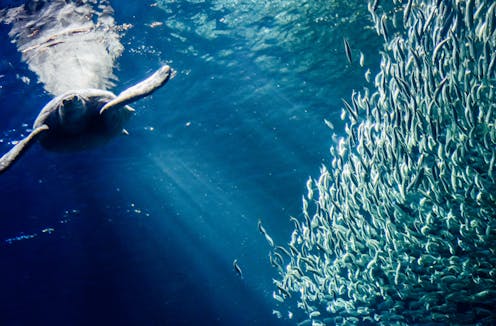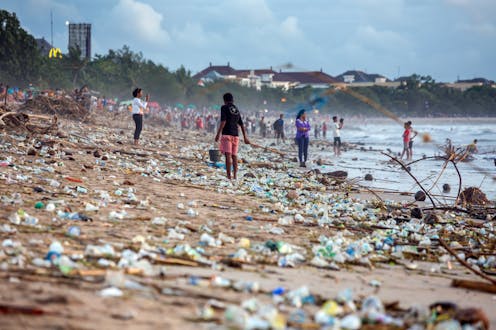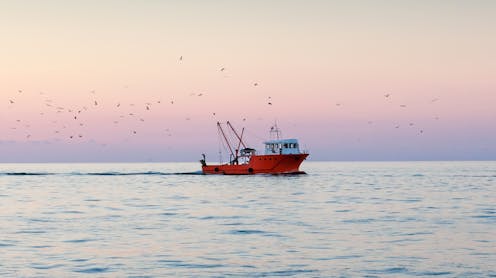Pollution guidelines leave a blind spot for assessing the impact of coal and oil
Coal’s impact on the Great Barrier Reef by causing climate change is one of the reasons why environmentalists oppose the development of coal fields and exports in Queensland. But fossil fuels could have a more direct impact on the reef and the waters around it, through chemicals produced during their production and distribution.
When coal dust is released in the marine environment it can damage marine ecosystems. Coal contains a number of different chemicals, but it is polynuclear aromatic hydrocarbons (PAHs), which are known carcinogens, that are of most concern.
Some components of coal PAHs cause biochemical changes in fish and can lead to cancer. The coal dust has a very slow degradation rate and will build up in the ecosystem from the continuous input.
Coal dust also absorbs chemicals in the coastal zone and transports things like pesticides and herbicides offshore. Oil spills are another source of PAHs in the marine environment.
It is currently impossible for Australia to assess the impact of these chemicals in marine sediments, because our sediment guidelines are out of date. They need to be updated to match the standards used elsewhere, such as in the United States.
Coal dust and Great Barrier Reef marine life
I have previously looked at how far these chemicals can travel from coal ports. I found they can be detected in suspended sediments all the way to the shelf break 200km offshore. (I also published a corrigendum to this paper to correct data errors and to explain how sediment guidelines need to be updated.)
I used the Australian and the US Environment Protection Authority (EPA) sediment quality guidelines to assess the concentration of PAHs in the sediments and suspended sediments on the Great Barrier Reef. The guidelines are meant to indicate “trigger values” for the concentration of possible toxins. If trigger values are reached then sources should be curtailed.
My study showed the concentrations were below toxic levels as then defined by the US guidelines. But it is impossible to know based on the Australian guidelines because these guidelines don’t target the PAHs contained in coal or oil. To explain why, we have to go into a bit of chemistry.
The composition of the PAHs can indicate the source from coal, oil or combustion processes.
The US guidelines use 34 key PAH groups (a total of about 290 individual compounds) and are currently the best available for assessing oil pollution incidents.
The Australian guidelines do not assess the PAHs that are the major contributor to PAHs in coal and oil. The Australian guidelines specify only 20 “parent” PAHs. These guidelines are more relevant to combustion products.
When is it toxic?
The Australian guidelines consider PAHs reach toxic levels at 10-50 milligrams per kilogram of sediment. But research suggests this is way too high.
Modern assessments of oil spills now rely on the PAH content of oils in addition to the total oil content.
PAHs make up about 1% of total oil content. If you applied these guidelines to an oil spill, the toxic level of 10mg PAH per kg of sediment would equal 1,000mg of oil per kg. This oil content would kill everything in marine sediments.
For example, I and a colleague published a detailed study of fiddler crabs after the West Falmouth oil spill. We determined that total oil concentrations of 100-200mg oil per kg of sediment were toxic to juvenile crabs. Concentrations of 1,000mg per kg were toxic to adults and/or caused a number of impacts before the crabs died.
As PAHs make up around 1% of most oils, this means that the trigger values should be 1mg PAH per kg (with a maximum of 5mg per kg). And this assessment must include the PAHs that are commonly found in oil and coal.
Commercial Australian labs don’t assess all these PAHs yet, but neither did the American labs until it became necessary for assessing major oil spills such as the Exxon Valdez spill in Alaska and the Deepwater Horizon spill in the Gulf of Mexico. We should not wait for the next disaster to upgrade our capability.
Cleaning up coal ports
We also need the ports to reduce their inputs. Townsville port has reduced the dust emission from its powdered zinc and lead loadings.
The train cars are covered and one at a time enter a shed which is under negative pressure. The powder is dumped in a hopper, transported to the conveyors and loaded onto the ships with no or little dust escaping the process.
The cars are then rinsed before leaving the shed. Water is retained and filtered so no dust leaves the area.
Why can’t coal be handled the same way? Improvement in loading metal powders was brought on by public objections to the previous operations.
This would eliminate coal piles in the coastal zone which blow dust all over nearby cities such as Gladstone and leach into coastal creeks. We also need the Australian sediment quality guidelines for PAHs brought up to 21st-century standard.
Do we have to wait until we have another incident like the Montara platform explosion in the Timor Sea in 2010 before we update our guidelines and response times?
Kathryn Burns received funding from the Australian Institute of Marine Science for chemistry studies in the Great Barrier Reef lagoon 2008-2010, and retired in 2011.
Ocean Pollution News by The Conversation Australia


Wahoo Skip Bins prides itself on always providing quality customer service- by focusing on responsive communication, timely deliveries, and competitive rates. Wahoo Skip Bins offers a large range of bin sizes and delivers Sydney wide. Call us today!
ABN: 41490770553




